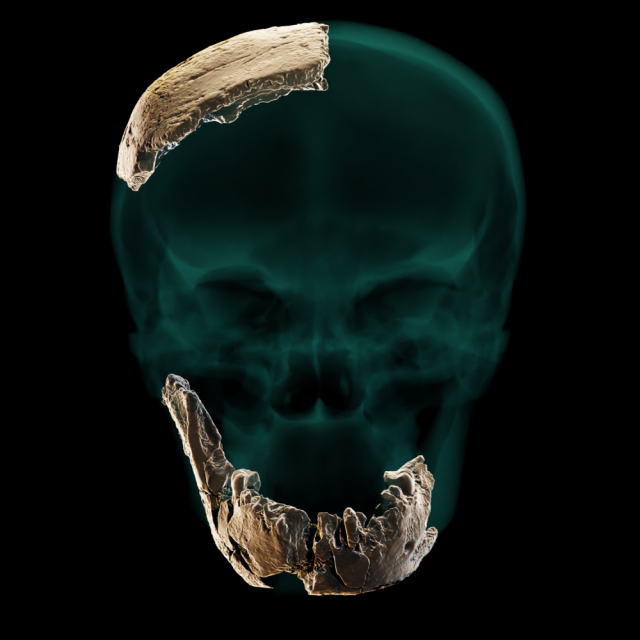Dramatic discovery in Israel: A new type of Homo unknown to science
Bones of an early human who lived in the Levant until 130,000 years ago were uncovered in excavations near Ramla. The Homo fossil identified for the first time was dubbed the Nesher Ramla

- The discovery of a new Homo group in this region similar to Pre-Neanderthal populations in Europe casts doubt on the widely held belief that Neanderthals originated in Europe, implying that at least some of the Neanderthals’ forebears originated in the Levant.
- Two distinct Homo groups coexisted in the Levant for more than 100,000 years (200-100,000 years ago), sharing knowledge and tool technologies: the Nesher Ramla people who lived there around 400,000 years ago, and the Homo sapiens who arrived later, about 200,000 years ago.
- It also sheds light on a long-standing puzzle in human evolution: How did Homo sapiens genes infiltrate the Neanderthal population that probably existed in Europe long before Homo sapiens arrived?
- The researchers assert that at least some of the later Homo fossils previously discovered in Israel, such as those in the Skhul and Qafzeh caves, do not belong to archaic (early) Homo sapiens to mixed Homo sapiens and Nesher Ramla lineages.
[embedded content]
Nesher Ramla Homo type – a prehistoric human previously unknown to science:
Nesher Ramla Homo type — a hitherto undiscovered archaic human: Tel Aviv University and the Hebrew University of Jerusalem researchers have discovered a new form of early human at the Nesher Ramla site, which dates to between 140,000 and 120,000 years ago.
According to the experts, the Nesher Ramla humans have morphological characteristics with Neanderthals (particularly the teeth and jaws) and archaic Homo (specifically the skull). However, this species of Homo is strikingly different from current humans, with an entirely different skull structure, no chin, and huge teeth.
The Nesher Ramla Homo type is believed to be the ‘source’ group from which most Middle Pleistocene humans developed. Furthermore, the finding suggests this species is the ‘missing’ population that mated with Homo sapiens who came to the region around 200,000 years ago, as revealed by a recent analysis of fossils discovered in the Misliya cave.

The dramatic discovery published in the prestigious Science journal. The culture, way of life, and behavior of the Nesher Ramla Homo are discussed furthermore in a companion paper Science journal today.
Two teams cooperated in this discovery. Anthropologists from Tel Aviv University headed by Prof. Israel Hershkovitz, Dr. Hila May, and Dr. Rachel Sarig. And archaeologists headed by Dr. Yossi Zaidner from the Hebrew University of Jerusalem.
Timeline: The Nesher Ramla Homo type was an ancestor of both the Neanderthals in Europe and the archaic Homo populations of Asia
Prof. Israel Hershkovitz: “Discovering a new species of Homo” is a significant scientific achievement. It helps us to make fresh sense of previously discovered human fossils, to add another piece to the human evolution puzzle, and to explain human migrations in the old world better. Even though they lived in the late middle Pleistocene (474,000-130,000 years ago), the Nesher Ramla people have a fascinating story to tell us about their descendants’ evolution and way of life.”
Dr. Zaidner of the Hebrew University discovered the significant human fossil during salvage excavations at the Nesher Ramla prehistoric site, near Ramla, in the mining region of the Nesher cement plant (owned by Len Blavatnik).
Excavators discovered a vast number of animal bones, including horses, fallow deer, and aurochs, stone implements, and human bones, after digging almost 8 meters underground. A multinational team lead by Tel Aviv and Jerusalem researchers classified the bones’ morphology as belonging to a previously undiscovered form of Homo. This is the first type of Homo to be defined in Israel, and they gave it the name Nesher Ramla Homo after the spot where it was found.

“People think in terms of paradigms,” Dr. Rachel Sarig explains. “That is why attempts have been made to assign these fossils to known human groups such as Homo sapiens, Homo erectus, Homo heidelbergensis, or Neanderthals. However, we now assert: No. This group is separate, with distinct qualities and characteristics.
At a later point, small groups of the Nesher Ramla Homo type migrated to Europe, where they grew into the ‘classic’ Neanderthals we familiar with. They also moved to Asia, where they became archaic populations with Neanderthal-like characteristics.
As a crossroads between Africa, Europe, and Asia, the Land of Israel functioned as a melting pot, bringing together diverse human populations that later spread throughout the Old World. The Nesher Ramla find adds a new and fascinating chapter to humanity’s history,” said Dr. Rachel Sarig
Prof. Gerhard Weber, an associate professor at Vienna University, says that this discovery alters the narrative of Neanderthal evolution: “Europe was not the only refuge for Neanderthals from which they sporadically spread into West Asia. We believe that lateral exchange occurred at a far higher rate in Eurasia, and that the Levant represents a critical starting place, or at the very least a bridgehead, for this process.”
Read more about: Archeology, Israeli archeology





